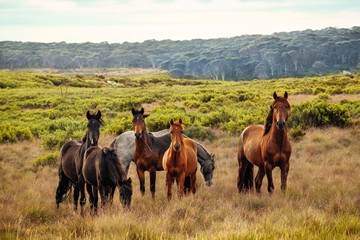 An environmental crisis in NSW national parks is the fallout from two decades of failed horse control sparked by the controversial Guy Fawkes River National Park feral horse cull 20 years ago.
An environmental crisis in NSW national parks is the fallout from two decades of failed horse control sparked by the controversial Guy Fawkes River National Park feral horse cull 20 years ago.
“The field evidence is in and the blanket ban on aerial culling in NSW has been a disaster for our national parks as horse populations in parks are without effective control,” Invasive Species Council CEO Andrew Cox said today.
“Horse numbers have exploded and native wildlife are slowly being replaced by a single species – the common horse.
“On the 20th anniversary of the Guy Fawkes incident it is time we learnt from the past and came up with more effective ways of controlling feral horses in remote and inaccessible national parks.
“If you are not going to effectively control feral horses in national parks you are better off handing the land back to the graziers.”
The feral horse reproduction rate can be as high as 20 per cent a year and has meant the fall-back method of trapping and removing the animals has failed to keep pace with the increase in numbers.
“Kosciuszko National Park now has 20,000 horses and, in some open plains, scenes resemble an equine Jurassic Park – herds of feral horses visible in all directions,” Mr Cox said.
“After the 2000 cull Guy Fawkes River National Park had less than 100 horses and yet despite a trap and removal program it is now home to about 1800 horses and rising.”
Between 22-24 October 2000, three professional shooters culled 606 feral horses in the Guy Fawkes River National Park that were stripping the park of remaining vegetation after a long drought and a severe bushfire.
When one horse was found alive days later, it triggered an independent inquiry, five reports and changed the way feral pest management was conducted in NSW with a blanket ban on aerial culling.
Despite the inquiry recommending aerial shooting be ‘retained’ as a method of control and that shooting protocols be improved, the aerial cull ban remains today.
“The ban on aerial culling has been an abysmal failure for the some 11 NSW national parks with feral horse populations. In almost all parks there has been an exponential growth in feral horse numbers and escalating damage,” Mr Cox said.
“It’s time to reflect on the anniversary of the Guy Fawkes incident and accept the reality of what it has meant for the NSW national parks system.
“Aerial shooting as a pest control option for large herbivores such as horses and camels is routinely carried out elsewhere in Australia under strict protocols and has cautious RSPCA endorsement.
“In some circumstances ground and aerial shooting is the only feasible and humane tool to curb the exponential growth in feral horse numbers and save and hopefully help restore what remains of what were unique environments and refuges for diminishing native animals and plants.”
As RSPCA NSW CEO Steve Coleman told the Sydney Morning Herald on Saturday, “That is the practical, brutal reality. It’s not nice, it’s not palatable, but it is the truth.”
“On the advent of this environmentally tragic anniversary for NSW national parks the Invasive Species Council calls on all parties to openly address the issues and move forward in a sensible fashion.
“It’s not a choice we want to make, but it is the only choice if we care about precious and irreplaceable environments like Kosciuszko National Park.”
More info
NSW Government e-petition is calling for urgent action on feral horse management. Dr Joe McGirr, member for Wagga Wagga, sponsored the petition. McGirr’s electorate covers the area of Kosciuszko National Park with the highest horse density.